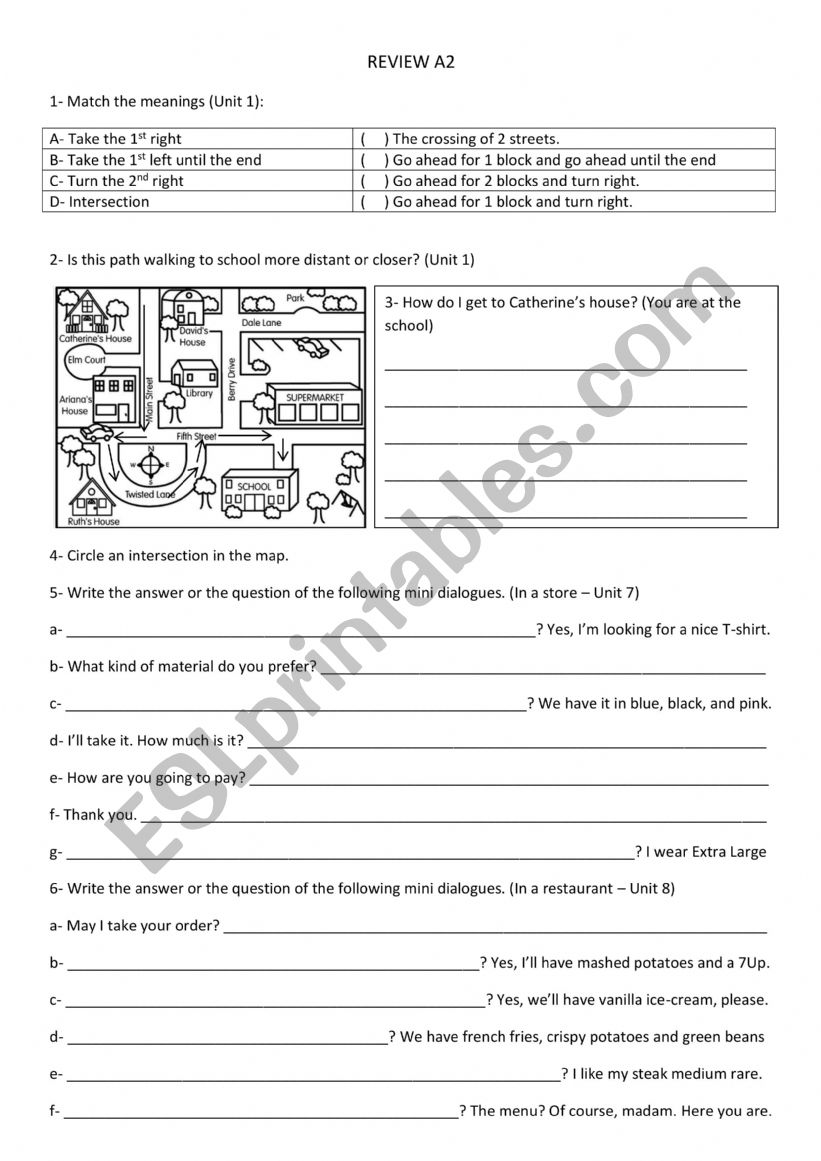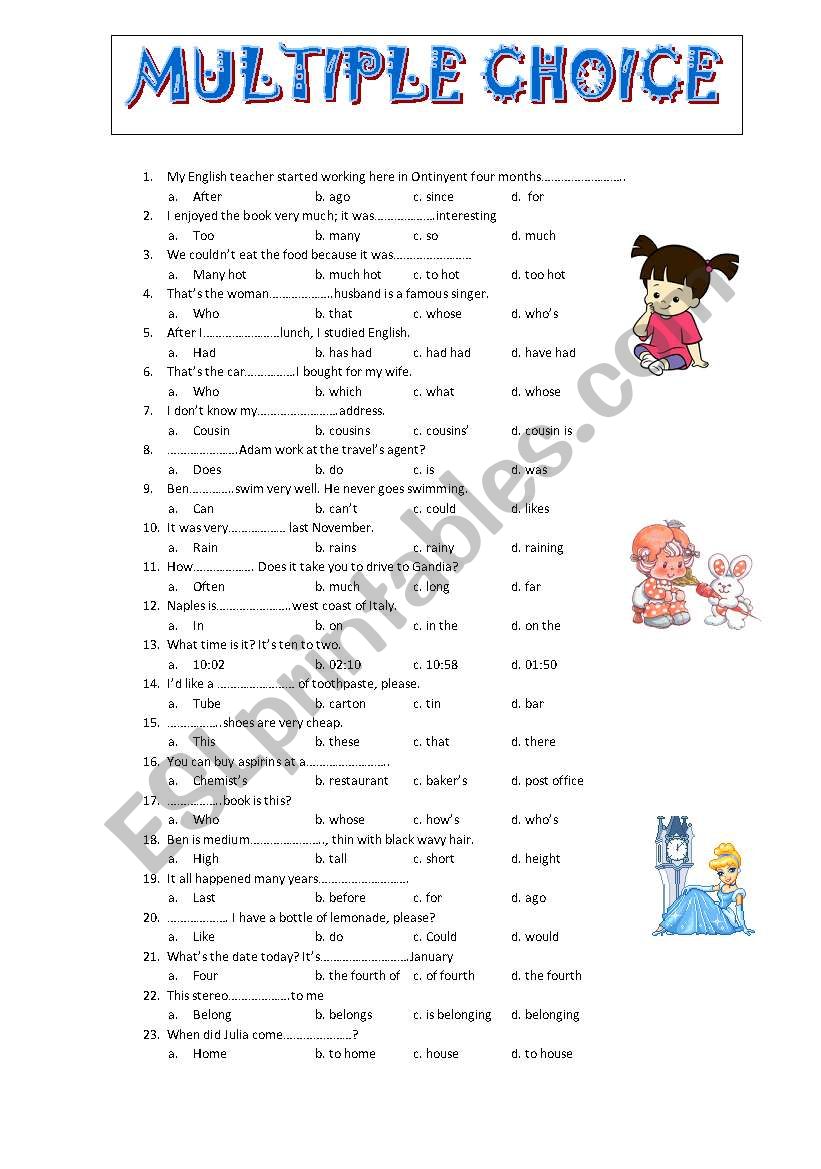
Mastering the Middle Ground: The Indispensable Role of A2 ESL Worksheets in Language Acquisition
Learning a new language is a journey, not a sprint. For English as a Second Language (ESL) learners, navigating the various stages of proficiency can be both exhilarating and challenging. Among these stages, the A2 level, as defined by the Common European Framework of Reference for Languages (CEFR), stands as a crucial bridge. It’s where beginners start to consolidate their foundational knowledge and venture into more practical communication. And at the heart of this consolidation and practical application often lie A2 ESL worksheets – a powerful, versatile, and often underestimated tool for both educators and independent learners.
This article delves deep into the significance of A2 ESL worksheets, exploring why they are indispensable, the diverse types available, how to effectively utilize them, and where to find high-quality resources to empower learners on their path to English fluency.
Understanding the A2 Level: The Foundation for Fluency

Before we extol the virtues of worksheets, it’s essential to grasp what the A2 level entails. Often referred to as "Waystage" or "Elementary," an A2 learner can:

- Understand sentences and frequently used expressions related to areas of most immediate relevance (e.g., very basic personal and family information, shopping, local geography, employment).
- Communicate in simple and routine tasks requiring a simple and direct exchange of information on familiar and routine matters.
- Describe in simple terms aspects of their background, immediate environment, and matters in areas of immediate need.
- Handle very short social exchanges, though they may not always grasp enough to keep the conversation going themselves.



Essentially, A2 is the stage where learners move beyond isolated words and basic phrases to forming simple sentences, understanding short texts, and engaging in basic conversations about everyday life. It’s a critical juncture where abstract grammar rules start to solidify into practical usage, and vocabulary expands from survival phrases to more nuanced descriptions. Without solidifying these skills, moving to the B1 (Intermediate) level becomes significantly harder.
The Indispensable Role of A2 ESL Worksheets

In this pivotal A2 stage, structured practice is paramount. This is precisely where A2 ESL worksheets shine. They offer a systematic and focused approach to reinforce learning, provide ample practice opportunities, and help learners identify and address their specific weaknesses.
- Reinforcement and Consolidation: Learners at the A2 level are constantly bombarded with new vocabulary, grammar structures, and communicative functions. Worksheets provide the necessary repetition and structured exercises to ensure that newly acquired knowledge is not just temporarily understood but deeply consolidated in their long-term memory.
- Targeted Practice: A good worksheet isolates a specific grammar point (e.g., past simple tense, prepositions of place) or a vocabulary set (e.g., food items, travel verbs). This targeted approach allows learners to concentrate on one area at a time, preventing cognitive overload and fostering mastery.
- Building Confidence: Successfully completing a worksheet provides tangible evidence of progress. This sense of accomplishment is a powerful motivator, boosting learners’ confidence and encouraging them to tackle more complex tasks.
- Identifying Gaps: As learners work through exercises, they inevitably encounter areas where they struggle. This self-assessment is invaluable, as it highlights specific knowledge gaps that can then be addressed through further study or teacher intervention.
- Versatility and Adaptability: Worksheets can be used for individual study, pair work, group activities, homework assignments, or even as quick assessments. Their flexibility makes them a staple in any ESL classroom or independent study routine.



Diverse Types of A2 ESL Worksheets
The variety of A2 ESL worksheets available is vast, catering to all aspects of language learning. Effective learning often involves a blend of these types:
-
Grammar Worksheets:
- Focus: Reinforcing specific grammar structures relevant to A2 learners. This includes, but is not limited to, simple present, past, and future tenses; present continuous; comparative and superlative adjectives; basic modals (can, must, should); prepositions of time and place; articles (a, an, the); and countable/uncountable nouns.
- Activities: Fill-in-the-blanks, sentence completion, multiple choice, sentence transformation (e.g., changing a statement to a question), error correction, matching sentence halves, or creating sentences from prompts.
- Example: A worksheet asking learners to complete sentences with the correct form of the verb in the past simple, or to choose between ‘much’ and ‘many’.
-
Vocabulary Worksheets:
- Focus: Expanding vocabulary related to common A2 themes such as daily routines, family, hobbies, food, travel, jobs, descriptions of people and places, and shopping.
- Activities: Matching words to definitions or pictures, crosswords, word searches, gap-fill exercises, categorizing words (e.g., "fruit" vs. "vegetables"), creating sentences using new words, or true/false statements based on vocabulary understanding.
- Example: A worksheet with pictures of different food items, requiring learners to label them, then use those words in simple sentences.
-
Reading Comprehension Worksheets:
- Focus: Developing the ability to understand short, simple texts on familiar topics. Texts are typically short emails, postcards, simple articles, advertisements, or descriptive paragraphs.
- Activities: Answering multiple-choice questions about the text, true/false statements, finding specific information, matching headings to paragraphs, or sequencing events.
- Example: A short text about a person’s daily routine, followed by questions like "What time does he wake up?" or "Does he like coffee?".
-
Writing Worksheets:
- Focus: Guiding learners to produce simple written output, moving from single sentences to short paragraphs.
- Activities: Sentence completion, guided writing prompts (e.g., "Describe your best friend"), filling in forms, writing simple emails or messages, describing a picture in short sentences, or completing story beginnings.
- Example: A worksheet providing sentence starters for describing a favorite holiday destination, or a template for writing a short email to invite a friend.
-
Listening Comprehension Worksheets:
- Focus: Improving the ability to understand simple spoken English, typically short dialogues, announcements, or descriptions.
- Activities: Gap-fill exercises while listening, answering questions about an audio clip, true/false statements, matching speakers to information, or ticking items heard in a list.
- Example: An audio clip of two people discussing weekend plans, followed by a worksheet asking learners to note down activities mentioned or answer who said what.
-
Speaking-Support Worksheets:
- Focus: While not direct "speaking" worksheets, these provide prompts and structures to facilitate oral practice.
- Activities: Role-play cards, discussion questions related to a topic, picture description prompts, interview questions, or sentence frames for expressing opinions.
- Example: A worksheet with two role-play cards for a simple shopping scenario (customer and shop assistant), providing key phrases for each.
Crafting and Utilizing Effective A2 ESL Worksheets
For teachers creating or selecting A2 ESL worksheets, and for learners using them, several principles ensure maximum effectiveness:
- Clear Instructions: Instructions must be unambiguous and easy for an A2 learner to understand. Use simple language and, where possible, provide an example.
- Appropriate Difficulty: The challenge should be just right – not too easy to be boring, not too hard to be discouraging. It should stretch the learner slightly.
- Variety is Key: Mix up activity types to keep learners engaged. Don’t just do gap-fills; incorporate matching, multiple-choice, and short answer tasks.
- Relevance and Engagement: Use topics that are relatable and interesting to A2 learners. Everyday situations, personal experiences, and cultural topics can make worksheets more engaging.
- Scaffolding: Provide support when needed, such as word banks for vocabulary exercises or sentence starters for writing tasks. Gradually remove this support as learners progress.
- Answer Keys: For independent learners, answer keys are crucial for self-correction and understanding mistakes. For teachers, they save time.
- Visuals: Pictures, diagrams, and simple illustrations can greatly enhance comprehension and make worksheets more appealing, especially for visual learners.
For learners, merely completing a worksheet isn’t enough. The real learning happens in the review:
- Review Mistakes: Understand why an answer was wrong. Is it a grammar rule? Vocabulary? Comprehension?
- Speak It Out: Read sentences aloud, especially those with new vocabulary or grammar, to practice pronunciation and build fluency.
- Connect to Real Life: Try to use the learned vocabulary or grammar in real conversations or personal writing.
- Consistency: Regular practice with worksheets, even for short periods, is more effective than sporadic long sessions.
Where to Find High-Quality A2 ESL Worksheets
The digital age has made finding A2 ESL worksheets easier than ever. Here are some reliable sources:
- Dedicated ESL Websites: Many websites specialize in ESL resources, offering free or subscription-based worksheets. Popular examples include ESL-Kids, ESL Printables, BusyTeacher, and ISLCollective.
- Teacher Blogs and Forums: Many experienced ESL teachers share their self-created materials and recommendations on their blogs or in online forums.
- Educational Marketplaces: Platforms like Teachers Pay Teachers allow educators to buy and sell high-quality, often meticulously designed, worksheets and activity packs.
- Textbook Companions: Most ESL textbooks come with accompanying workbooks or online resources that include targeted A2-level exercises.
- AI Tools (with caution): AI language models can generate basic worksheets, but they often require significant editing and verification for accuracy and pedagogical soundness. They can be a good starting point for ideas.
When selecting worksheets, always check the source’s credibility, read reviews if available, and ensure the content aligns with the specific learning objectives of the A2 level.
Conclusion
A2 ESL worksheets are far more than just busywork; they are fundamental tools that provide structure, targeted practice, and vital reinforcement for learners transitioning from basic survival English to more confident communication. They bridge the gap between abstract linguistic concepts and practical application, helping learners solidify their grammar, expand their vocabulary, and improve their reading, writing, and listening comprehension.
Whether you are an educator meticulously planning your lessons or an independent learner striving for self-improvement, incorporating a diverse range of A2 ESL worksheets into your routine will undoubtedly accelerate progress. They are the quiet workhorses of language acquisition, laying down the solid foundation upon which true fluency can be built. By embracing their power and utilizing them effectively, A2 learners can confidently navigate their language journey, step by step, worksheet by worksheet, towards a more articulate and expressive command of English.
